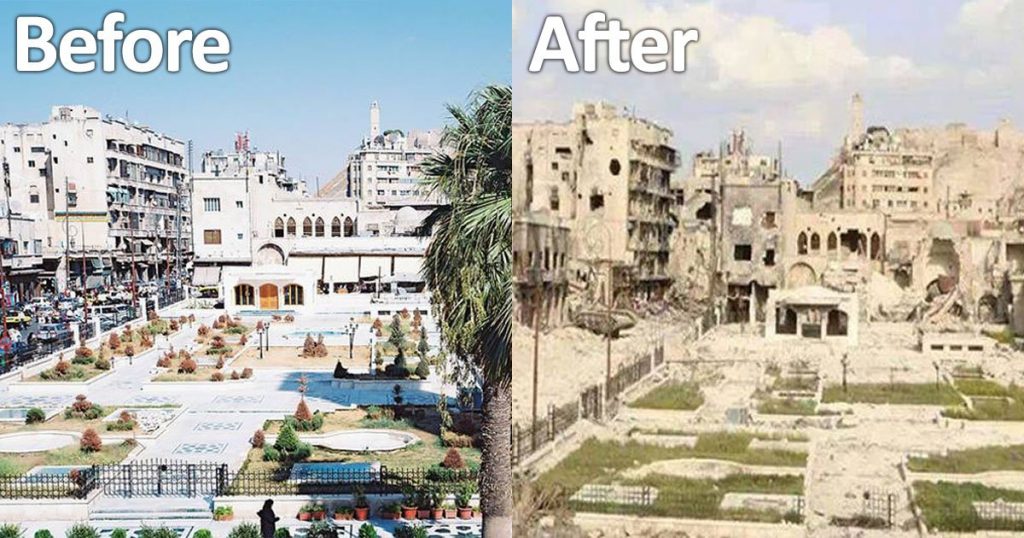Late late night I read the first news reports of our president’s authorization of the launch of fifty missiles on Syrian air bases. (He warned the Russians in advance so their soldiers would leave, wanting to avoid a direct conflict with Russia.) It appears this morning that we hit military targets and human casualties will be small, perhaps even none. The reason for this attack was the outrage felt by our nation, and our president, upon seeing the helpless children who had died at the hands of President Assad through the use of chemical weapons. (Of course, Assad is denying he was behind this and blames the rebellion for the use of such weapons.)
I am deeply troubled by these events. Let me explain why.
Is this strike a one-time military action? If not, what is our strategy going forward? If there is “no red line” that Assad can cross to lead us into a “hot war” with him (which Mr. Trump promised for months he would not do) then why did these photos of dead children prompt this response and why now? Is there a policy for follow-up? As I understand the military the development of “war games” scenarios are routine. Military options are always on the table for every president to ponder. So, in all fairness, the president decides that something must be done and the military gives him his options and he seeks the counsel of his advisors and then uses his power to choose one of the options.
Why am I concerned? Assad is an evil man and has killed his own people. He has also used chemical weapons before this week. This civil war was has been ongoing since 2011. During the so-called “Arab Spring” Syrian opposition groups, allied against President Assad, formed the Free Syrian Army (FSA) and seized control of the area surrounding Aleppo and parts of southern Syria. Over time, several factions split from their original moderate position to pursue an Islamist vision for Syria. In 2015, the Yekîneyên Parastina Gel (YPG) joined forces with Arab, Assyrian, Armenian, and some Turkmen groups, to form the Syrian Democratic Forces, while most of the Turkmen groups remained with the FSA. Both Russia and Hezbollah engaged militarily in support of the Syrian government. In 2014, a coalition of NATO countries began launching airstrikes against what is called ISIS or ISIL. Turkey, and others, still lobby for airspace that is free of Syrian planes. President Trump has been focused on forging an alliance with Russia, and others, for the purpose of defeating ISIS inside Syria, at least until yesterday. Time will tell what happens now regarding Assad and his government forces, who were oddly enough thought to be our allies against ISIS. 
International organizations almost universally agree that human rights violations and vast massacres have occurred inside Syria. As a result of this long civil war at least 4.8 millions people have fled Syria, which is the largest such refugee crisis since World War II. Inside of Syria another 6 million people have been displaced from their towns and homes, often destroyed by Assad’s forces. All of this makes Syria the most tragic war in the world since the 1940s. Over the course of this civil war several number of peace initiatives have been tried. In March of this year the United Nations tried again but the fighting against Syrian people by their own president only ramped up again over the last few weeks. Then these brutal photos were seen globally and America acted when our President was sickened by what he saw.
Isn’t our response a no-brainer, you ask? Well, yes and no. I suggest peacemaking requires further, and more broadly based, attempts to solve the problem before we kill many more people, intended or otherwise. I am not suggesting avoidance of the problem, just the opposite. I am also suggesting that we need context. I am particularly reminded of the strategy that Pope Francis proposed to the government of the U.S. regarding our use of military force:
- He urged our government to face hard facts.
- He urged only an proportionate use of force if necessary.
- He urged us to acknowledged that military response alone cannot succeed.
- He urged us to scale up our humanitarian assistance to refugees.
- He urged that we accept resettlement where return to Syria is impossible.
It seems this morning that only number two has been seriously attempted by the U.S. government in the last three months. Time will tell if this is really the case.
Before this Syrian Civil War there were 22 million people inside Syria. 2 million of these Syrians were Christians. Syria has been historically very tolerant toward Christians. (By the way, Syria is a historic and important land to Christianity. After all, the famous city of Damascus is in Syria!) Historically Christians and Muslims lived peaceably in Syria for centuries. The truth is that this is not a conflict between Christians and Muslims at all. Syria has long been a repressive state and long denied basic human rights, at least since the modern state was formed in 1947!
Why is Russia involved so deeply in Syria? This is a complicated question but it has to do with Russian political interests in the Middle East as a counterbalance to Israel and the U.S. I have come to believe, based on listening to Christians who live in this region explain this conflict, that it also has to do with the influence of some Christian leaders inside Russia. These leaders have urged Putin to support Assad because they have their own interests in the region. This might not be true but I see many reasons to believe that it is so. This some Christians have complicity added to the number and horror of human deaths inside Syria by playing partisan politics. (This should make us all consider the role Christians have in supporting nationalism under the banner of Christ!)
Around 45% of the Christian population of Syria has fled or died. About a million Christians now remain. Here is a simple observation, again supported by Christians in and near Syria. Our Christian divisions have uniquely hurt our witness and hindered our efforts to work for peace.Ecumenism really does matter. In this instance it has a direct impact on the world around us.
Here is my concern about our actions taken last night: There no easy response to suffering and the use of chemical weapons. Launching missiles will not stop this carnage in itself. (See numbers 1-3 in Pope Francis above.) Unless we follow this action of last night with the other four proposals of Pope Francis we are not going to make a real difference in Syria for lasting peace. Entering this civil war is not appropriate. The president said so for months. So what next? “Pray and work for peace, period.” Urge lawmakers to read the pope’s list and respond accordingly, with balance and actions. If force must be used make sure it is appropriate and well-thought-out (in advance) and make sure there is a more holistic response behind it.
For me personally, pray for the peace of Syria! And work for the rescue and resettlement of those who are fleeing death. Mr. President, please stop hindering the resettlement of Syrian refugees.
I shudder to think we launched missiles at several military sites but that we will do almost nothing more to save the lives of people inside Syria, and fleeing it every day, where we can and should act with compassion and sacrifice. If we do nothing but cheer and then beat our chests, saying “God bless America,” then nothing will really change. “Blessed are the peacemakers.”






Comments are Closed